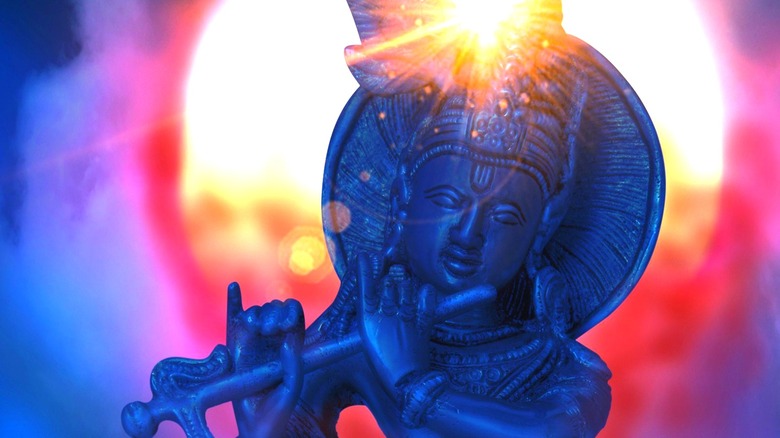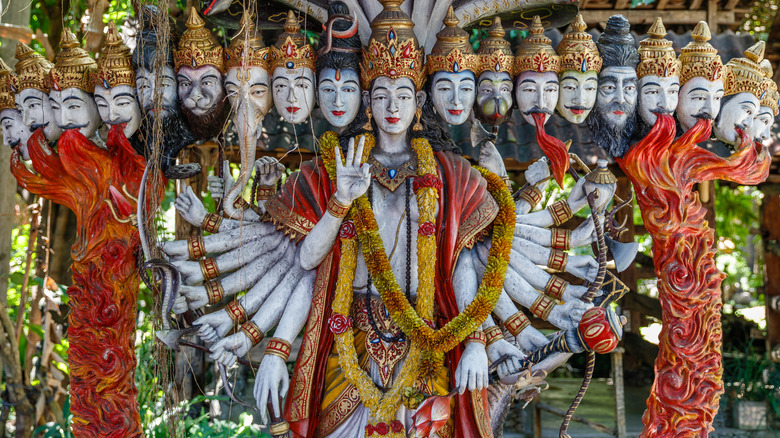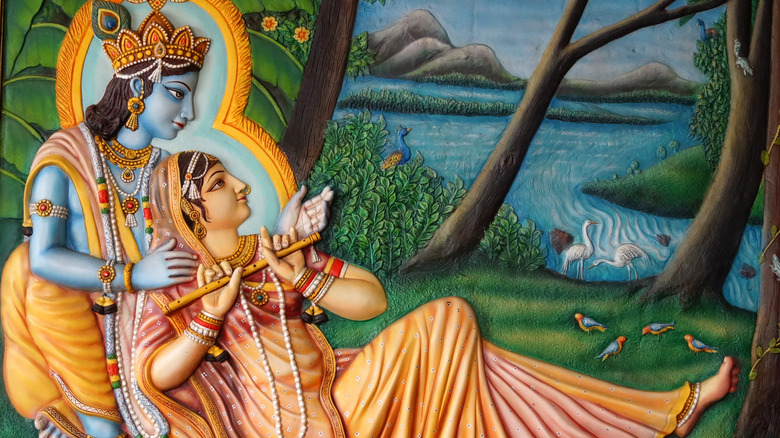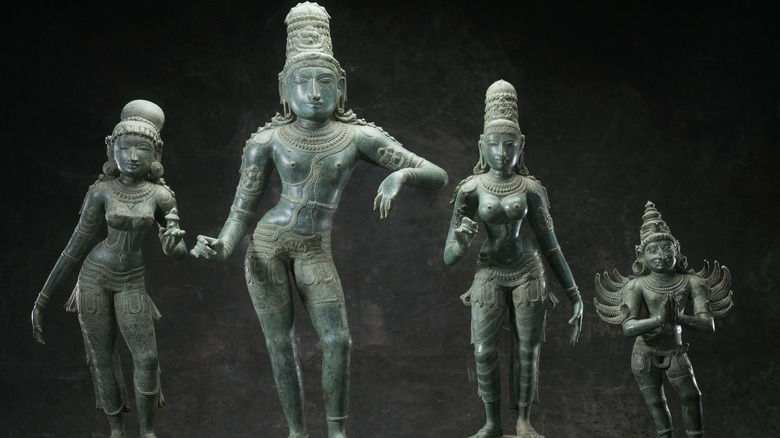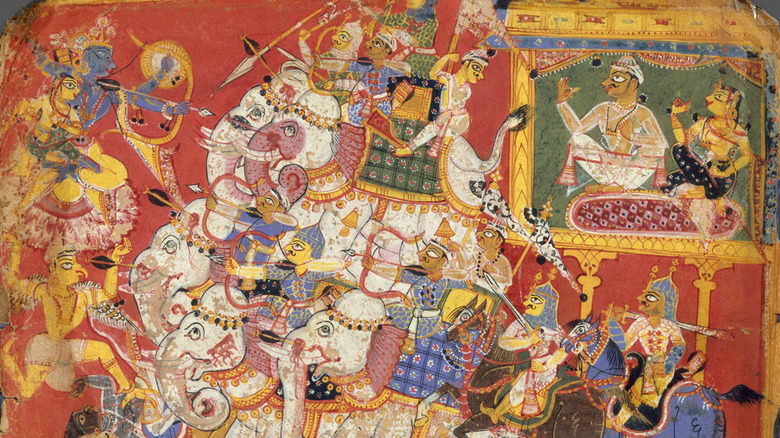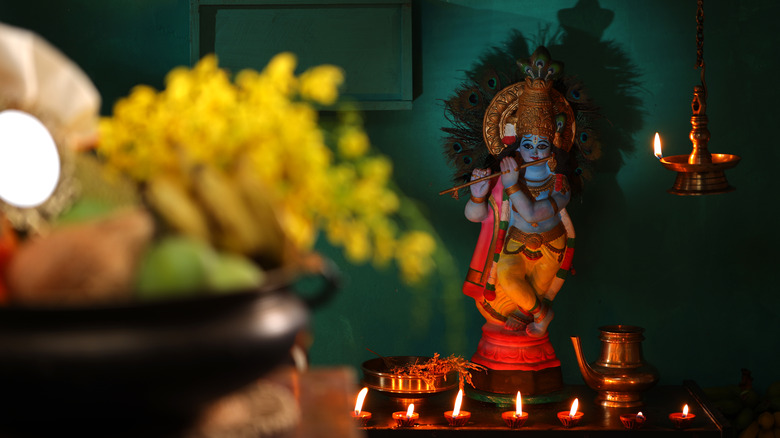Why Does Krishna Have So Many Wives?
Folks unfamiliar with Hinduism might find it odd to learn that Krishna, a major Hindu deity, had quite a lot of wives. And we don't just mean several, or an assemblage, or even an Ottoman imperial harem's worth. We mean a full-on 16,108 wives (yes, that number specifically). But before the reader makes any leaps of judgment, or assumes that Krishna was some fiend with a bottomless pit of a sexual appetite who arbitrated a town-sized coterie of captive sex slaves, it would pay to learn a bit about Krishna and the reason why he wound up so wife-replete.
For the uninitiated, Hinduism and its precepts aren't just something that exists in books or long-dead stories of ancient civilizations, like tales of Osiris from Egyptian myth, or Poseidon from Greek myth. As World Population Review cites, there are over 1.2 billion living Hindus the world over, centered in Hinduism's birthplace, India, and extending to countries that either fell under Indian influence or became home to Indian immigrants, like Nepal, Bangladesh, Indonesia, or Sri Lanka. The United States alone is home to about 2.5 million Hindus. Part of Hinduism's uniqueness derives from its age — about 5,000 years old, per Britannica – and an overall lack of influence from outside beliefs.
Krishna wound up with so many wives because he rescued them from a demon. As Vedic Feed explains, they were risen to a protected, honorific status, and became Krishna's "brides" in the way that Catholic nuns call themselves "Brides of Christ."
The 8th incarnation of Vishnu
Krishna is one of the 10 incarnations of Vishnu, one of Hinduism's chief three deities along with Brahma and Shiva, as Daily Art Magazine overviews. Brahma is the original creator of the universe, depicted as an older man with four heads each facing in a different direction. He's considered a bit more remote and abstract than Vishnu and Shiva. Shiva is the destroyer god, and so doubles as a deity of renewal. He's usually depicted as a kind of wise hermit in meditation. And Vishnu? He's the preserver, or stabilizer, of the universe over time. He incarnates here on Earth in times of need.
Krishna, then, is the eighth incarnation of Vishnu out of 10. The ninth incarnation was the Buddha. We've got one more incarnation to go — Kalki — before the cycle of ages ends. There are four ages total, as Zee News explains — this is the fourth and final age, Kali Yuga, before everything gets obliterated and starts over.
As Vishnu's avatar, embodiment, etc., Krishna is both himself and also Vishnu, similar to Christianity's "Jesus is God" tenet. And like Jesus, Krishna is an ostensibly "good" or "holy" figure. He exists to defeat evil, uphold justice, protect cosmic balance — that sort of thing. As he says in the Bhagavad Gita (per Hinduism Facts), "For the protection of the good, for the destruction of evil-doers, for the sake of firmly establishing righteousness, I am born from age to age."
Tales from the Bhagavad Gita
Much of what we know about Krishna comes from the Bhagavad Gita, a 700-line poetic passage from the Mahabharata, a massive, 100,000-stanza collection of tales of gods and humans compiled in print around 350 CE, as Brown University explains. The Mahabharata and the Bhagavad Gita are part of the Hindu faith and derived from one of the oldest, if not the oldest, set of religious texts in existence, the Vedas. The Vedas were first written down in Sanskrit from 1,500 to 500 BCE in modern-day India, and derived from pre-literate traditions going back much, much further, as World History describes.
The Vedas talk about how Vishnu periodically incarnates here on Earth to fulfill his cosmic purpose as "preserver and protector of the created world," as Emory University puts it. Otherwise, he sort of hangs out and sleeps in space on the "cosmic ocean of milk" (the Milky Way) with his giant, nine-headed serpent, Anantha-Sesha, as a bed. This serpent, per Dharmakshrethra, represents the continuity of time that passes from age to age — it's the part of the universe that will always be preserved, even as more transitory things (like people) vanish.
We learn a lot about Krishna, Vishnu's ninth incarnation, in the Bhagavad Gita. The Bhagavad Gita contains quotable quotes from Krishna like, "It is I who am the ritual, I the sacrifice, the offering to the ancestors, the healing herb, the transcendental chant. I am the butter and the fire and the offering."
Krishna's original eight wives
Krishna had eight original wives during his time as a human, as Vedic Feed relates. Collectively known as "Ashtabharya," these women – Rukmini, Satyabhama, Jambavati, Kalindi, Mitravrinda, Nagnajiti, Bhadra, and Lakshana — were a combination of incarnate goddesses like Lakshmi (wife of Vishnu), princesses, warriors, gifts to Krishna for performing some feat, and so on. Each has a different relationship to Krishna, although they all bore children by him. Some wives adopted the role of lovers, others friends, others devotees, and others general companions.
Jambavati, for instance — Krishna's second wife — was the daughter of the bear Jambavan who took a sacred gem, the Syamantaka, and gave it to his son as a toy to play with (don't worry about these stories making literal sense). Krishna was accused of stealing the gem, and tracked it down to Jambavan's cave, where Jambavan, in contrition, offered his daughter Jambavati (yes, a human) to Krishna as his wife. Krishna received another wife, Nagnajiti, as a gift after taming seven bulls, and Kalinda after coming across her doing penance along a river, while Satyabhama was the embodiment of the Earth Goddess, Bhumidevi.
When learning about these stories, it's important that folks in a predominantly monogamous, Christianized present, avoid projecting any modern values onto ancient peoples who did just fine for millennia without our judgments. By and large, polygamy is not unusual in subsistence-based societies that rely on childbirth for literal survival, as sites like Religious Tolerance overview.
Krishna's war against the demon, Narakasura
Krishna got a huge boost in the number of wives following a particular demon-fighting episode described in a section of the original Vedas (written 1,500 – 500 BCE) known as the Srimad Bhagavatam. The Srimad Bhagavatam contains a whopping 18,000 verses and is considered "the essence of all the Vedas," as Vedic Feed describes. While the Bhagavad Gita stands out as the "precious jewel" or "universal gospel" of Hinduism, the Srimad Bhagavatam contains certain episodes from myth considered extremely important. Both, however, focus on Krishna, which might help to explain why his popularity has persisted to the present.
The tale in question centers on a time when Krishna was a clan chieftain in Dwarka, a city on India's west coast that sunk into the ocean (and is currently being investigated by underwater archaeologists, as the BBC describes). Around the same time, a king named Narak ruled an area of northeastern India called Pragjyotishpur. Narak was an asura, a minor demon constantly at war with the gods, or devas, as Temple Purohit explains. This is why Narak is sometimes called Narakasura (Narak + asura).
Under the influence of another asura named Banasura, Narakasura went on a military campaign and swept over "all the kingdoms on Earth" (Dwarka, Krishna's home, wasn't a kingdom). Along the way, Narakasura captured and enslaved a grand total of 16,100 women. This is when the goddess Aditi approached one of Krishna's wives, the aforementioned Satyabhama, to entreat Krishna for help.
The rescue of 16,100 captives
Vedic Feed tells us that Satyabhama went to her husband Krishna to convince him to fight the demon, Narakasura, and was especially infuriated by Narakasura's enslavement of the 16,100 women. It bears noting that out of all of Krishna's wives, Satyabhama was the most like a "soulmate" to him, and treated him like a regular person and not a deity, as Vedic Feed also describes. Krishna treated her more like an equal, in turn, and set on adventures and travels with her, including into the fight against Narakasura.
Krishna and Satyabhama rode together in the battle against Narakasura's forces on the back of Garuda, Krishna's mythical half-man, half-bird mount. As the reader can guess, they defeated the demon, but it was Satyabhama, not Krishna, who dealt Narakasura the killing blow with her bow and arrow. Before this, Krishna had paved the way by killing Narakasura's general, Mura. The rescued women were so grateful, and adored their rescuers so much, that they all wanted to marry Krishna. And so, Krishna elevated them all to the status of princess and wound up with 16,108 wives, including his original eight.
This part of the story is so well-known, in fact, that folks in southern and western India believe it's the reason we've got the modern Hindu festival, Diwali (Katha Kids even has a kid's version of the tale). Upon rescuing the women Krishna declared, "Let this day be celebrated as a day of feasting in the world!"
